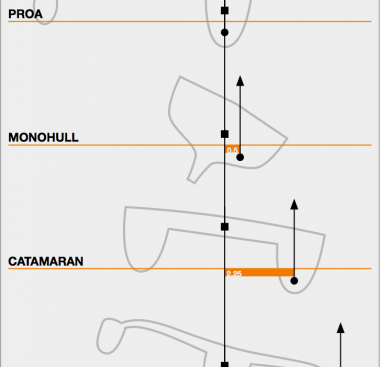The Case for the Cargo Proa
Inspired by tales of the early American schooner trade (er… smuggling), I recently sat down to draw a multihull version of an inter-island or coastal cargo schooner. Monohull traders have been done a thousand times, but maybe something interesting might be had by an examination of the multihull.
My ideal cargo multihull would be manageable by a small crew, perhaps as few as 3 or 4. It would operate wherever the trade-winds provide consistent horsepower, enough to rely on. Cargo could be anything, from barrels of diesel to copra to tea, at least 5 tons of cargo capacity, 10 would be better.
And that’s when I ran into the problem of widely variable displacement on a multihull, because displacement x righting arm = righting moment, and righting moment governs everything else in the design of a sailing vessel. The long righting arm of the multihull multiplies displacement into a formidable beast.
For yachts, the displacement does not vary too much once the crew and stores are aboard. Yes, water, food and fuel come and go over the course of a voyage, but cargo is another matter. Laden displacement of a cargo vessel could be 4-5 times the empty weight.
See Fig. 2 (in gallery above), which compares righting arms of a generic 10m cat, trimaran, monohull - and a proa. The trimaran is the worst case, having a righting arm a full 7.5 times the length of the monohull. The cat’s arm is 4.5 times the mono. Like monohulls, cargo on multihulls is loaded on centerline (a cat would load both hulls as equally as possible to get the same result). The loads on the structure of a heavily laden catamaran or trimaran will be immense.
It is prudent to design for worst case, or the most laden condition (which is also “best case” for the skipper, since his boat is full of goods to be sold). A heavily laden multihull has an enormous righting moment, leading to bigger sails, greater stresses, larger and stronger structural members, adding even more weight, and up the design spiral we go. The vessel quickly becomes expensive to build, maintain and to operate, cutting into profit and the reason for building the boat in the first place. Conversely, when the multihull is lightly laden it is needlessly overbuilt and over-canvased.
The only way around this conundrum is with the proa, which does not require bilateral symmetry.
On a proa, cargo may be loaded entirely into the leeward hull, which is also the center of buoyancy. There will be very little change in righting moment no matter how heavily laden the proa might be (within reason, we are not talking about submerging the decks here). With a proa, righting moment is handled by the weighted ama and outrigger structure to windward, not buoyancy to leeward. The righting moment remains consistent, meaning stress, scantlings and sail area will also remain consistent between laden and unladen. This leads to a well-engineered and efficient structure through a widely varying displacement.
Conceptually, the proa decouples the driving force from the overall displacement. Sailing loads do not skyrocket as cargo is loaded. The ship should sail and handle much the same whether laden or unladen, the only difference being speed attained.
The handling problems of a proa still remain - shunting is more trouble than tacking. However on long voyages, particularly in the trades, the necessity for tacking is reduced. Besides, if the economics pan out, then the captains of cargo proas may consider the handling trade-off to be well worth it.
When lightly laden, the proa would still be capable of the speeds that made them famous. This will make for fast return passages, as well as spirited racing. After all, every cargo schooner must race!
See Understanding monohull sailboat stability curves by Matthew B. Marsh for a good primer on righting moments.



Hi Michael,
I’m with you on this. It’s funny how the original usage of all boats was about moving people/cargo and over time that morphed into a racing sport. Not that that’s a bad thing. Just interesting. So yeah, proas hold such a big, untapped potential for being great, simple, cheap (and quick!) cargo movers. Any renditions on your design desk?
Cheers
Claudio